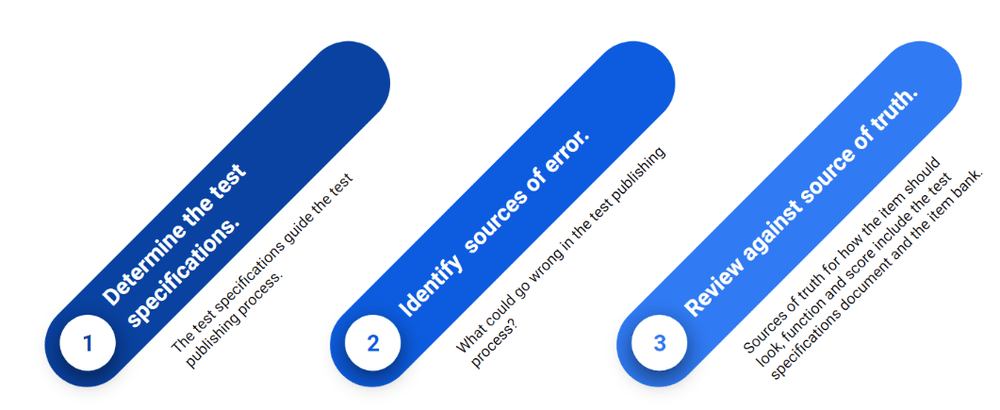Test publishing is the process of preparing computer-based assessments for delivery on an electronic platform. Test publishing is like a car rolling off the assembly line. It’s the culmination of a great deal of effort in developing the assessment. Just as a car undergoes extensive checks before leaving the factory, a computer-based assessment requires meticulous quality control procedures to make sure that it functions as intended. Errors may have significant consequences for the sponsoring organization, including a loss of reputation, and can even have legal implications, depending upon the type of error.

The test publishing quality control process begins prior to the start of the publishing process. The key steps in the process are as follows:
Step 1: Determine the test publishing specifications
Quality control begins with the completion of a test specifications document. The test specifications document provides the pattern or the playbook for how the test should be published. It typically includes the following information:
- Test design
- Administration model (i.e., linear fixed form, LOFT, CAT)
- Scoring strategy (dichotomous/polytomous item-level scoring, compensatory/conjunctive domain/sectional scoring)
- Test length (number of items shown to each candidate)
- Test duration (time allowed for exam/sections)
- Content specifications
- List of included items (and which are scored/unscored)
- Mapping of items to domains/sections/subscales (if applicable)
- Mapping of stimuli to items (if applicable)
- Item keys
- Ancillary delivery components
- Non-disclosure agreement
- Tutorial
- Customized help screens
- Calculator
- Features and functionality
- Navigation (e.g., review of previous items allowed)
- Review screens
- Electronic scratch pad
- Item-level comments/feedback
Note that this is not a comprehensive list, and information needed for the test specifications documents may vary depending upon the type of assessment and the specific testing platform used for delivery. Some of the data on the test specifications are relatively static and will change only with changes to the test design. Other data, such as the list of included items, are dynamic and will typically change each time the assessment is republished.
The test specifications document becomes the authoritative source of truth used by the test publisher for how the assessment should be published. It is a key communication tool between the sponsoring organization and their test publishing vendor or partner.
Step 2: Identify sources of test publishing errors
A comprehensive determination of everything that could possibly go wrong in the test publishing process should serve as the guide for the quality control checks that need to be performed before the test goes live. A tool that can assist in developing a comprehensive list of potential errors is a fishbone diagram, also known as an Ishikawa diagram or a cause-and-effect diagram. It is a visual representation used to identify and organize possible causes of a specific problem or effect. The diagram takes the form of a fish skeleton (hence, its name), with the “head” representing the problem or effect, and the “bones” representing different categories of potential causes. Along each bone, smaller branches represent sub-causes, which are specific elements that may contribute to the problem.
Fishbone diagrams are created by having a team representing all disciplines involved in a process brainstorm potential problems, or in the case of test publishing, potential errors that can be introduced into the test publishing process. Determining potential categories of errors first and then brainstorming more specific errors enables a comprehensive analysis of the test publishing process and the potential occasions in which errors can be introduced in that process.
Here’s a sample fishbone diagram for test publishing errors:

Step 3: Review against source of truth
The examination should be reviewed against the source of truth for each potential error. The test specifications will be the key source of truth against which the published examination is compared to identify any errors. The item bank is the source of truth for item presentation and item metadata.
Error-free test publishing is central to preserving the test sponsor’s reputation. Even minor mistakes, such as misspelled words, can be damaging. More importantly, errors in a published examination can have deleterious effects for candidates. A scoring error might mean the difference between a candidate failing and passing, and in the case of a certification or licensure examination, that can have dire consequences for the candidate’s career and livelihood.
As mathematician Nassem Nicholas Taleb stated, “Quality is the result of an intelligent effort, not a chance happening.” A rigorous quality control procedure aids in making the publishing process an intelligent effort.

